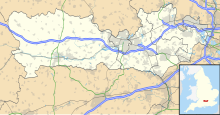Kennet and Lambourn Floodplain
| Site of Special Scientific Interest | |
 Rack Marsh | |
| Location | Berkshire Wiltshire |
|---|---|
| Grid reference | SU 370 691[1] |
| Coordinates | 51°25′12″N 1°28′08″W / 51.420°N 1.469°W |
| Interest | Biological |
| Area | 23.4 hectares (58 acres)[1] |
| Notification | 1996[1] |
| Location map | Magic Map |
Kennet and Lambourn Floodplain is a 23.4-hectare (58-acre) biological Site of Special Scientific Interest in six widely separated areas in the floodplains of the River Lambourn in Berkshire and the River Kennet in Wiltshire, England.[1][2] It is a Nature Conservation Review site[1] and part of the Kennet and Lambourn Floodplain Special Area of Conservation.[3] One of the areas, Rack Marsh, is managed by the Berkshire, Buckinghamshire and Oxfordshire Wildlife Trust.[4]
These six areas all have fen or swamp with large numbers of Desmoulin's whorl snail, which is listed in the British Red Data Book as it is a nationally rare and declining species. One of the areas, Eddington Marsh, also has unimproved species-rich grassland with several nationally scarce invertebrates, such as the flies Pherbellia griseola, Psacadina verbekei, Platypalpus niger and Oxycera morrisi.[5]
Locations[edit]
- SU316705 51°25′56″N 1°32′43″W / 51.4321°N 1.5454°W
- SU402737 51°27′37″N 1°25′17″W / 51.4604°N 1.4213°W
- SU345687 51°24′57″N 1°30′14″W / 51.4158°N 1.5038°W
- SU435701 51°25′40″N 1°22′27″W / 51.4278°N 1.3743°W
- SU453692 51°25′10″N 1°20′55″W / 51.4195°N 1.3485°W
- SU450674 51°24′12″N 1°21′11″W / 51.4034°N 1.3530°W
- Location SU556655 51°23′07″N 1°12′03″W / 51.3853°N 1.2009°W is shown as a seventh area in the citation, but the citation also says that there are only six areas in the site[5] and it is not shown on the Natural England map.[2]
References[edit]
- ^ a b c d e "Designated Sites View: Kennet and Lambourn Floodplain". Sites of Special Scientific Interest. Natural England. Retrieved 17 February 2020.
- ^ a b "Map of Kennet and Lambourn Floodplain". Sites of Special Scientific Interest. Natural England. Retrieved 17 February 2020.
- ^ "Designated Sites View: Kennet & Lambourn Floodplain". Special Areas of Conservation. Natural England. Retrieved 4 October 2019.
- ^ "Rack Marsh". Berkshire, Buckinghamshire and Oxfordshire Wildlife Trust. Retrieved 4 October 2019.
- ^ a b "Kennet and Lambourn Floodplain citation" (PDF). Sites of Special Scientific Interest. Natural England. Retrieved 17 February 2020.

